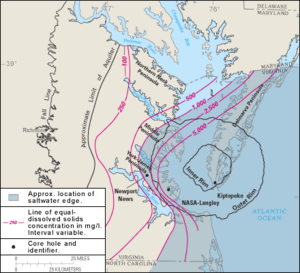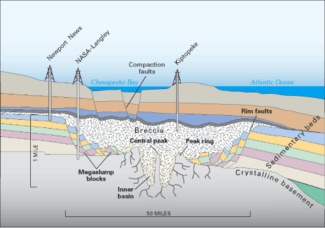Chesapeake Bay impact crater facts for kids

Location of impact site in relation to the United States
|
|
| Impact crater/structure | |
|---|---|
| Confidence | Confirmed |
| Diameter | 53 miles (85 km) |
| Depth | 0.81 miles (1.3 km) |
| Impactor diameter | 1.9 miles (3 km) |
| Age | 35.5 ± 0.3 million |
| Exposed | No |
| Drilled | Yes |
| Bolide type | L chondrite |
| Location | |
| Location | Chesapeake Bay |
| Coordinates | 37°17′N 76°1′W / 37.283°N 76.017°W |
| Country | United States |
| State | Virginia |
| Municipality | Cape Charles |
| Access | U.S. Route 13 to S.R. 184 |
The Chesapeake Bay impact crater was formed when a giant space rock, called a bolide, crashed into the eastern shore of North America. This huge event happened about 35.5 million years ago, during a time called the late Eocene epoch. It is one of the best-preserved impact craters in the world that formed in a watery area.
Over time, dirt and rocks inside the crater kept shifting. This shifting helped create the shape of the Chesapeake Bay we see today.
Contents
How the Crater Formed
A Warm, Ancient World
Back in the warm late Eocene period, the ocean was much higher. The area of Virginia known as the Tidewater region was covered by shallow sea water. The coast of eastern North America, near where Richmond, Virginia is now, was a thick tropical rainforest. The ocean waters were full of tiny sea creatures. These creatures left behind thick layers of a chalky material called calcium carbonate from their microscopic shells.
The Giant Impact
The space rock hit the Earth super fast, at almost 60 kilometers (about 37 miles) per second! It punched a huge, deep hole right through the dirt and into the hard granite rock beneath the continent. The space rock itself completely turned into gas from the heat. The hard rock underground cracked up to 8 kilometers (about 5 miles) deep. A raised ring of rock, called a peak ring, formed around the center.
The deep hole, or crater, was about 38 kilometers (about 24 miles) wide. It was surrounded by a flat, ring-shaped area with collapsed blocks. The entire circular crater is about 85 kilometers (about 53 miles) across and 1.3 kilometers (about 0.8 miles) deep. This area is twice the size of Rhode Island and almost as deep as the Grand Canyon. However, some scientists think the crater was originally closer to 40 kilometers (about 25 miles) wide right after the impact.
After the Crash
The area around the impact suffered massive damage. A scientist from the USGS, David Powars, helped discover this crater. He described what happened right after the impact. "Within minutes, millions of tons of water, sediment, and shattered rock were cast high into the atmosphere for hundreds of miles along the East Coast."
An enormous megatsunami, a giant wave, covered the land. It might have even reached the Blue Ridge Mountains. The sides of the crater, made of soft dirt, slowly collapsed inwards. This made the crater wider. Huge blocks of rock fell onto the crater floor. These blocks were then covered with a jumbled mix of broken rocks called breccia. The whole event, from the crash to the breccia settling, lasted only a few hours or days. In terms of Earth's history, the 1.2-kilometer (0.75-mile) thick breccia layer formed almost instantly. Over the next 35 million years, more layers of dirt and rock piled up, burying the crater.
Scientists believe this impact created the North American tektite field. Tektites are small, glassy objects formed when a meteorite hits Earth.
How it Was Discovered
Until 1983, no one knew about a large impact crater buried under the lower part of the Chesapeake Bay. The first clue was a 20-centimeter (about 8-inch) thick layer of material found in a drilling sample. This sample was taken off Atlantic City, New Jersey, about 170 miles north. This layer contained tiny, fused glass beads called tektites and shocked quartz grains. These are clear signs of a space rock impact.
In 1993, information from oil exploration helped scientists understand how big the crater was.
Impact on Local Rivers
The constant shifting of the rocks and dirt inside the crater has changed how local rivers flow. It also helped shape the Chesapeake Bay. The impact created a long-lasting dip in the land. This dip helped decide where the rivers would flow and where the Chesapeake Bay would eventually be.
The impact also affected the underground water sources, called aquifers. Today, the fresh water aquifers sit above a deep layer of salty water. This salty water is left over from ancient ocean water, about 100 to 145 million years old. This means the lower Chesapeake Bay area can easily have its fresh groundwater become salty.




